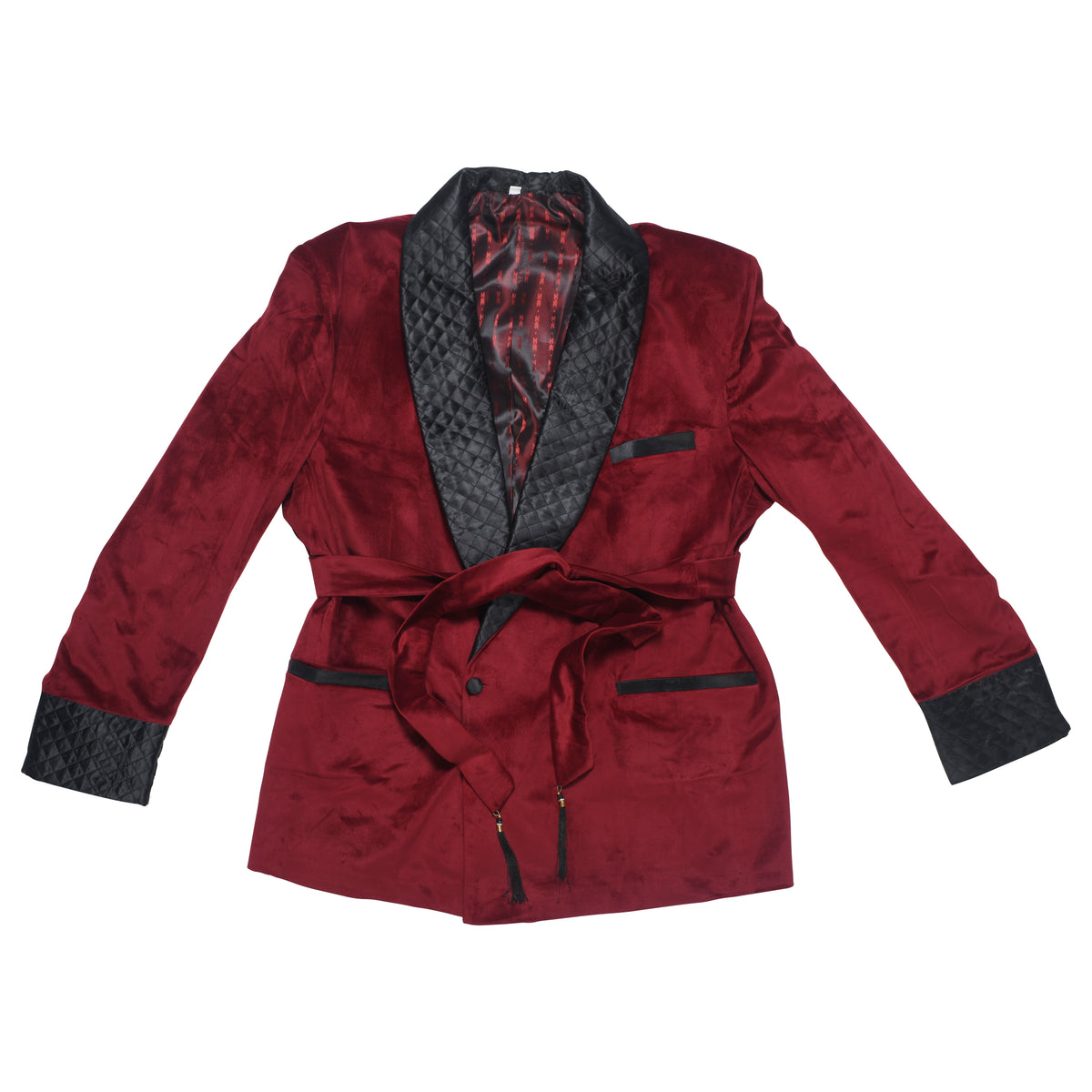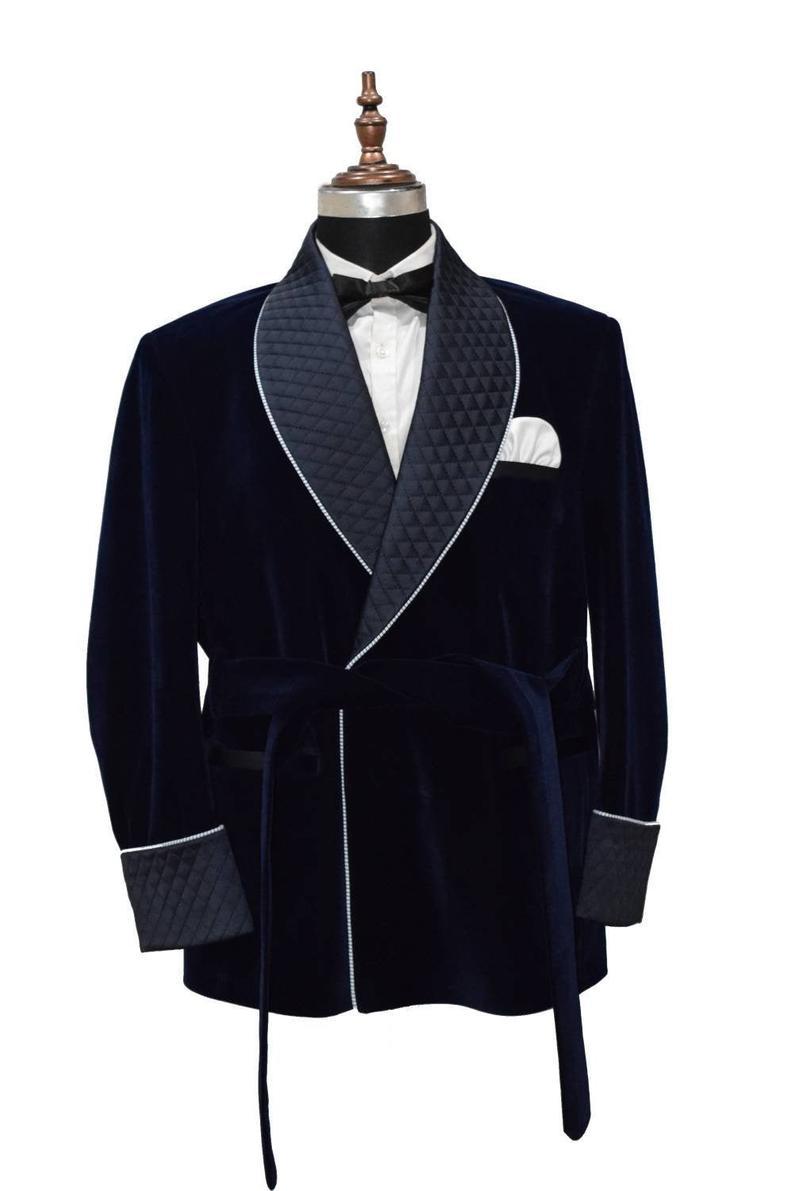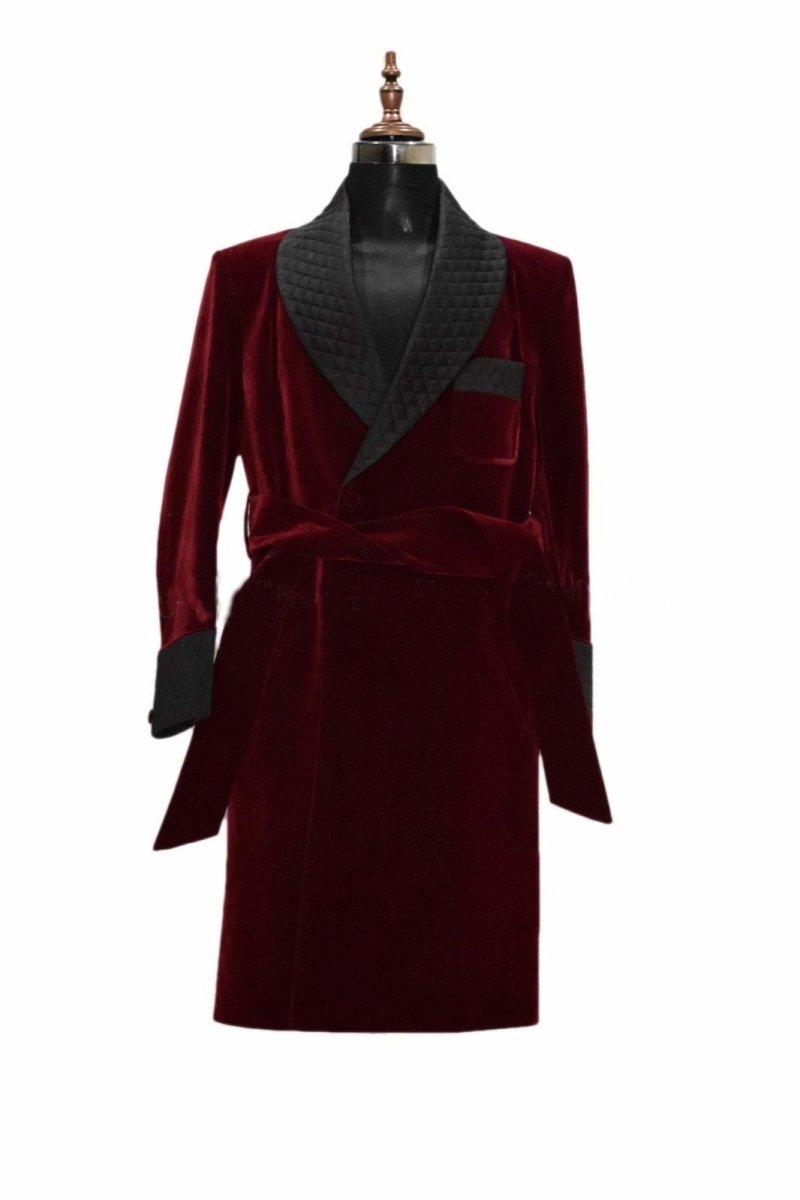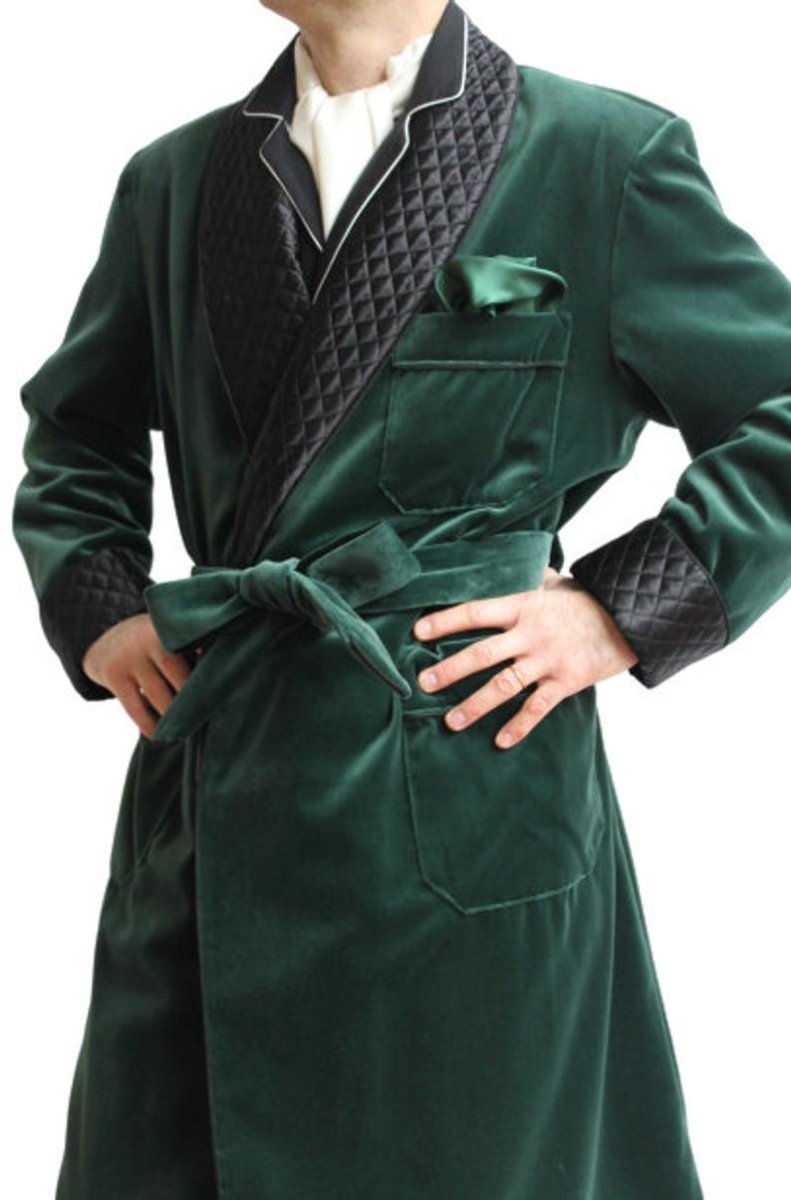The smoking jacket or smoking robe is one of those iconic pieces of men's fashion that seems very tied to a specific time and place. It makes many men think of smoky clubs and high-class parties, the kinds of places that have all but disappeared in a more casual era. What few realize, though, is that this type of jacket is actually quite an old garment. With a history that dates back almost as far as the European importation of tobacco, these jackets have adapted to ensure that they will stick around no matter how fashion changes.
Tobacco found itself lumped in with the other exotic products of the 17th century in Europe, with the ever-expanding empires of Britain, France, and Spain connecting the world's commercial hubs in ways that hadn't been seen since the fall of Rome. Suddenly the well-to-do were able to not only smoke tobacco but clothe themselves in garments made of silk from Asia.
Silk and tobacco went together as high-priced, high-class luxuries. Though tobacco would eventually find its way to the common man, silk would continue to be a status symbol. In fact, the silk dressing gowns that kept individuals worn were so luxuries that they simply had to be shown off. These gowns would adorn men of many social classes in the portraits, giving Europe an entirely new look for leisure.
It's important to remember that these earlier precursors to smoking jackets had more to do with the exotic nature of both tobacco and silk than smoking. These were still very much the dressing gowns that men used to keep warm at night and to ensure they wouldn't get food on themselves as they dined, but worn in portraiture.
In fact, one can make an argument that the original smoking robes had more in common with modern haute couture than modern jackets. These were garments that were made to be seen and envied, not merely to serve a practical function. These were the kinds of garments that people aspired to own and that would drive fashion for years to come.
There was something about these garments that captured the imagination even as fashions went through its usual evolutions. As men's fashion changed, the dressing gown would adapt. It would take a few more decades for the next step in the evolution of the smoking jacket to catch on, though.
The garment in question was known as a Banyan, a style that was largely thought to be the European iteration of a Japanese concept. Still made of silk, this garment was a single piece that fit loosely over one's nightclothes, perfect for relaxation and warmth. The style would come not from the cut of the garment but its construction, with silk as a base and complex patterns becoming more common as the financial ability of the wearer climbed.
The Banyan went through a few different iterations over the course of the 18th century. It grew a shawl collar that modern readers would know better as a lapel, something that would become a key part of the design of smoking jackets. The garment's cut and length would also begin to change, slowly approaching something that resembles more of a modern jacket cut.
It would again take an influx of eastern influence to change the jacket's design, but the end of the 18th century really did see this garment come near its final evolution. The jacket might not have been quite what it is today, but it was clear that something very much like the jacket would be a part of the wardrobes of men all over Europe and the Americas for decades to come.
Men in the 19th century did not have wardrobes quite as large as their peers in the modern era. As such, their clothes needed to be protected as much as possible. Men needed an outer garment that would not only protect them from stains while eating at home, but that would also protect them from tobacco ash when smoking. It was then that the jacket made its biggest push into the life of higher-class men all over the English-speaking world.
This jacket does, however, owe a great deal to one more item of clothing - the dinner jacket. The dinner jacket was shorter and didn't feature the tails of the Victorian and Edwardian tailcoat, making it a much more functional garment for wearing during meals. The new iteration of the jacket would ape a great deal of this garment's cut, with the jacket itself experiencing a few different permutations that would allow men to comfortably dine while wearing this sort of garb. By the end of the 19th century, the smoking robe was a sign of elegance, sophistication, and social grace.
Smoking jackets suddenly became a sign of not just wealth, but of cool. Worn by men like Fred Astaire and Carey Grant, they suddenly became a fashion staple even in public. As time went by, they would become increasingly associated with the playboy lifestyles of the Rat Pack, with men like Dean Martin and Frank Sinatra adding the jackets to their repertoires. Though the jackets would continue to have at least some association with tobacco going forward, they became equally as associated with being confident and debonair.
Perhaps the biggest icon to wear this type of jacket in the 1950s was Hugh Hefner. The Playboy founder would be known for his collection of smoking jackets until the day he died, but his star power in the 1950s quickly made the jacket a symbol of masculinity. Men who wanted to embrace the lifestyle espoused by men like Hefner found themselves buying jackets of varying quality, with the jackets becoming less functional and more of a symbol.
Nothing lasts forever, though, and the end of the 1960s would bring about the end of these unique jackets as widely-worn garments. As society grew to embrace more casual styles, the formality of the jacket suddenly seemed to be quite out of place.
A huge part of the reason why this type of jacket began to fall out of favor was the changing attitude in the 1980s and 1990s towards tobacco. As the links between tobacco and cancer became more apparent, the concept of tobacco chic fell out of favor as well. Men would continue to smoke, of course, but the spaces set aside for smoking were now more for isolation than for celebration. Men who smoked largely did so quickly, efficiently, and without the need for anything special to signify the event.
The vast majority of these robes that would be worn for over the course of these three decades would be worn in jest. They would be low-quality Halloween costumes or props for sleazy characters in movies. A few great examples of the jackets would still be used in specific clubs, but the widespread wearing of these smoking robes would fade away with time.
The end of the 20th century would, however, see a shift in how the jackets were seen. Now they would no longer just be old, but retro. As the decade came to a close, they'd be thought of as having a kind of throwback cool, a sort of style that hearkened back to more elegant days. With this change in attitude came a slow rebirth of the garments that would continue well into the 21st Century.
The practical aspect of the smoking robe has largely been set aside, both due to a lower tobacco usage rate and due to the rise of ash-less alternatives like e-cigarettes. Instead, these jackets are now a part of the fashion world, regularly taking their place on the red carpet. Oddly enough, it does seem that these jackets are returning to their roots as something meant to be shown off and admired rather than as garments that are simply made for a practical purpose.
It should also be noted that today's version of smoking jackets often have a lot more in common with traditional dinner jackets than their older counterparts. Silk is out for the most part, largely replaced with velvet. The cut of the jackets is almost identical to that of typical dinner jackets, with the biggest difference being the substitution of wool for more luxurious fabrics. These garments are now meant to add a bit of color and flair to an outfit rather than to protect the wearer's other clothing from damage.
Smoking jackets may be less common than they were many years ago but that doesn't mean they are gone. With nearly four hundred years of history behind them, it's unlikely that these jackets are ever going to go anywhere. They will change with the times, substituting new fabrics and new cuts as the need arises, but ultimately they'll stick around for those who like the intersection of sophistication and comfort that these jackets represent.
The 17th Century: The Dressing Jacket Fad
This type of jacket is, as one might expect, intimately connected to the growth and popularity of tobacco use. Tobacco first made its way to Europe in the late 16th century, with the earliest crops imported from the New World and planted in Spain. By the 17th century, though, tobacco had become something more than just a fad - it had become a major part of European life.Tobacco found itself lumped in with the other exotic products of the 17th century in Europe, with the ever-expanding empires of Britain, France, and Spain connecting the world's commercial hubs in ways that hadn't been seen since the fall of Rome. Suddenly the well-to-do were able to not only smoke tobacco but clothe themselves in garments made of silk from Asia.
Silk and tobacco went together as high-priced, high-class luxuries. Though tobacco would eventually find its way to the common man, silk would continue to be a status symbol. In fact, the silk dressing gowns that kept individuals worn were so luxuries that they simply had to be shown off. These gowns would adorn men of many social classes in the portraits, giving Europe an entirely new look for leisure.
It's important to remember that these earlier precursors to smoking jackets had more to do with the exotic nature of both tobacco and silk than smoking. These were still very much the dressing gowns that men used to keep warm at night and to ensure they wouldn't get food on themselves as they dined, but worn in portraiture.
In fact, one can make an argument that the original smoking robes had more in common with modern haute couture than modern jackets. These were garments that were made to be seen and envied, not merely to serve a practical function. These were the kinds of garments that people aspired to own and that would drive fashion for years to come.
There was something about these garments that captured the imagination even as fashions went through its usual evolutions. As men's fashion changed, the dressing gown would adapt. It would take a few more decades for the next step in the evolution of the smoking jacket to catch on, though.
The 18th Century: The Banyan
The next big step in the evolution of the jacket actually draws its inspiration from another garment - the kimono. Though the need for a dressing gown was still evident in 18th Century Europe, the fashions of the continent had changed. While silk was all the rage, it was time to change things up when it came to the basic shape of the dressing gown. No longer would it be the garment featured in portraits, but now something a little more suitable for wear only at home.The garment in question was known as a Banyan, a style that was largely thought to be the European iteration of a Japanese concept. Still made of silk, this garment was a single piece that fit loosely over one's nightclothes, perfect for relaxation and warmth. The style would come not from the cut of the garment but its construction, with silk as a base and complex patterns becoming more common as the financial ability of the wearer climbed.
The Banyan went through a few different iterations over the course of the 18th century. It grew a shawl collar that modern readers would know better as a lapel, something that would become a key part of the design of smoking jackets. The garment's cut and length would also begin to change, slowly approaching something that resembles more of a modern jacket cut.
It would again take an influx of eastern influence to change the jacket's design, but the end of the 18th century really did see this garment come near its final evolution. The jacket might not have been quite what it is today, but it was clear that something very much like the jacket would be a part of the wardrobes of men all over Europe and the Americas for decades to come.
The 19th Century: Turkish Tobacco and New Styles
The Banyan and its tributary garments would stay popular for the first few decades of the 19th century, but the Crimean War brought with it a number of societal shifts. One of the most important, at least from a consumer standpoint, was the fact that cheap, Turkish tobacco would now be available throughout Europe. Tobacco smoking would become a much larger part of male life and special garments would be needed to allow men to really enjoy the experience.Men in the 19th century did not have wardrobes quite as large as their peers in the modern era. As such, their clothes needed to be protected as much as possible. Men needed an outer garment that would not only protect them from stains while eating at home, but that would also protect them from tobacco ash when smoking. It was then that the jacket made its biggest push into the life of higher-class men all over the English-speaking world.
This jacket does, however, owe a great deal to one more item of clothing - the dinner jacket. The dinner jacket was shorter and didn't feature the tails of the Victorian and Edwardian tailcoat, making it a much more functional garment for wearing during meals. The new iteration of the jacket would ape a great deal of this garment's cut, with the jacket itself experiencing a few different permutations that would allow men to comfortably dine while wearing this sort of garb. By the end of the 19th century, the smoking robe was a sign of elegance, sophistication, and social grace.
1900-1970: Style and Comfort
The first half of the 20th century was almost certainly the heyday of the smoking jacket. From 1900 to 1950, men would continue to wear these fashionable jackets in the way that they did in the 19th century. It was almost certainly the kind of garment that was the purview of the rich and powerful, though those who aspired to the same status would delight in the garments as well. Smoking jackets gained a reputation for not only being comfortable but also for being elegant. It's of little wonder, then, that they would soon find a place outside of the house.Smoking jackets suddenly became a sign of not just wealth, but of cool. Worn by men like Fred Astaire and Carey Grant, they suddenly became a fashion staple even in public. As time went by, they would become increasingly associated with the playboy lifestyles of the Rat Pack, with men like Dean Martin and Frank Sinatra adding the jackets to their repertoires. Though the jackets would continue to have at least some association with tobacco going forward, they became equally as associated with being confident and debonair.
Perhaps the biggest icon to wear this type of jacket in the 1950s was Hugh Hefner. The Playboy founder would be known for his collection of smoking jackets until the day he died, but his star power in the 1950s quickly made the jacket a symbol of masculinity. Men who wanted to embrace the lifestyle espoused by men like Hefner found themselves buying jackets of varying quality, with the jackets becoming less functional and more of a symbol.
Nothing lasts forever, though, and the end of the 1960s would bring about the end of these unique jackets as widely-worn garments. As society grew to embrace more casual styles, the formality of the jacket suddenly seemed to be quite out of place.
1970-2000: Throwback Cool
The period between 1970 and 2000 was undoubtedly the darkest period for most types of formal wear. The jacket wasn't just seen as dated - it was seen as a joke. Hefner's magazine might not have dropped in popularity, but the man himself was an easy target for parody. The most commonly seen smoking jackets were now in the possession of Hefner pastiches, with many men abandoning the less than elegant image it now portrayed.A huge part of the reason why this type of jacket began to fall out of favor was the changing attitude in the 1980s and 1990s towards tobacco. As the links between tobacco and cancer became more apparent, the concept of tobacco chic fell out of favor as well. Men would continue to smoke, of course, but the spaces set aside for smoking were now more for isolation than for celebration. Men who smoked largely did so quickly, efficiently, and without the need for anything special to signify the event.
The vast majority of these robes that would be worn for over the course of these three decades would be worn in jest. They would be low-quality Halloween costumes or props for sleazy characters in movies. A few great examples of the jackets would still be used in specific clubs, but the widespread wearing of these smoking robes would fade away with time.
The end of the 20th century would, however, see a shift in how the jackets were seen. Now they would no longer just be old, but retro. As the decade came to a close, they'd be thought of as having a kind of throwback cool, a sort of style that hearkened back to more elegant days. With this change in attitude came a slow rebirth of the garments that would continue well into the 21st Century.
21st Century: A Renaissance
The 21st Century saw a renaissance in the world of smoking jackets. The popularity of shows set in the 1950s like Mad Men gave a whole new generation an appreciation for the jackets and specialty retailers would once against start to stock them. Though the jackets still haven't seen the same kind of market penetration that they would have seen in the 1950s, the internet made it easier than ever for men to find one of these jackets.The practical aspect of the smoking robe has largely been set aside, both due to a lower tobacco usage rate and due to the rise of ash-less alternatives like e-cigarettes. Instead, these jackets are now a part of the fashion world, regularly taking their place on the red carpet. Oddly enough, it does seem that these jackets are returning to their roots as something meant to be shown off and admired rather than as garments that are simply made for a practical purpose.
It should also be noted that today's version of smoking jackets often have a lot more in common with traditional dinner jackets than their older counterparts. Silk is out for the most part, largely replaced with velvet. The cut of the jackets is almost identical to that of typical dinner jackets, with the biggest difference being the substitution of wool for more luxurious fabrics. These garments are now meant to add a bit of color and flair to an outfit rather than to protect the wearer's other clothing from damage.
Smoking jackets may be less common than they were many years ago but that doesn't mean they are gone. With nearly four hundred years of history behind them, it's unlikely that these jackets are ever going to go anywhere. They will change with the times, substituting new fabrics and new cuts as the need arises, but ultimately they'll stick around for those who like the intersection of sophistication and comfort that these jackets represent.





0 comments